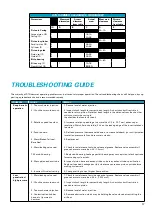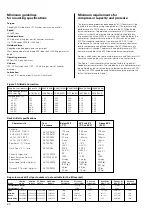
5
Live air
Never get under a downhole drill to examine the exhaust air; live
air is dangerous. Also, part failure could cause the bit to fall out
of the downhole drill which could result in bodily injury. A piece
of cardboard can be inserted under the bit to check
for the lubrication being carried through the downhole drill.
Air pressure
Make certain that the air line lubricator (or lubrication system) is
capable of handling the higher air pressures associated with the
downhole drill (up to 350 psi (24.13 bar) air pressure). When
pressurized, an unsuitable lubricator could burst and possibly
cause injury to personnel in the area.
Do not work in trench
Do not work in trench with unstable sides which could cave
in. Specific requirements for shoring or sloping trench walls
are available from several sources including Federal and State
O.S.H.A. offices, and appropriate governing agency. Be sure to
contact suitable authorities for these requirements before
working in a trench. Federal O.S.H.A. regulations can be
obtained by contacting the Superintendent of Documents, U.S.
Government Printing Office, Washington, D.C. 20402. State
O.S.H.A. regulations are available at your local state O.S.H.A.
office, and appropriate governing agency.
Check laws and regulations
Know and obey all Federal, State and Local, and appropriate
governing agency laws and regulations that apply to your work
situation.
Place warning barriers around work site
Set up orange cones around the work area with warning signs
facing outward.
Place pedestrian and traffic barriers around the job site in
accordance with Federal, State and Local, and appropriate
governing agency laws and regulations.
Observe environmental protection
regulations
Be mindful of the environment and ecology.
Before draining any fluids, find the correct way of disposing
them.
Observe the relevant environmental protection regulations when
disposing of oil, fuel, coolant, brake fluid, filters and batteries.
When using any solvent to clean parts, make sure that it is
nonflammable, that it will not harm the skin, that it meets current
O.S.H.A. standards, and appropriate governing agency, and that
it is used in an area that is adequately ventilated.
Failure to follow any of the above safety instructions
or those that follow within this manual, could result in
serious injury or death. This DTH hammer is to be used
only for those purposes for which it was intended as
explained in this instruction manual.
WARNING
INSTALLATION AND
OPERATION
Follow instructions
Before operating this down-the-hole hammer for the first time,
become familiar with the operation of the machine and the
hammer .
Learn how to operate the machine and how to use the controls
properly. Do not let anyone operate this machine without proper
instruction.
If you do not understand any part of this manual and need
assistance, contact your local Atlas Copco dealer.
Description
The QLX line of down-the-hole hammers is designed for use on
drilling machines in conjunction with a top head or kelly drive
mounting. The mounting must be capable of supplying sufficient
hold down, hold back, rpm, torque, hammer lubrication, air
pressure and air volume.
DTH hammers achieve high productivity in hard rock
applications by adding percussion to the drilling process. Rotary
drilling methods use the combination of raw weight and rotation
to chip and carve rock from a hole. The rotary method works
fine in soft formations where adequate weight and stress can be
applied to the rock to initiate fracture and chipping. However, in
harder rock the rotary method cannot supply sufficient load on
the bit inserts to crack the rock and produce a chip. Percussion
drills overcome the rotary bit load limitation by producing a very
high load during impact of the hammer. This load is sufficient to
drive the cutting inserts into the rock to produce chips.
QLX DTH hammers are recommended for practically any hard
rock application. Depending on the size downhole drill being
used, they are suitable for drilling water wells, primary blast
holes in quarries, open pit mining, coal stripping operations, oil
and gas exploration, and construction jobs where large volume
rock excavation is required.
Common DTH hammers operate by using the position of a piston
to direct supply and exhaust air to and from drive and return
volumes. The drive volume ´drives´ the piston toward impact and
the return volume ´returns´ the piston in preparation for another
impact stroke. In order to maximize impact energy it is
desirable to deliver supply pressure to the drive volume while
the piston is at the top of its stroke, and, turn off the supply
pressure when the piston is nearly at its impacting position.
However, conventional DTH hammers which use position
dependent fixed porting are not able to alter the position at
which supply pressure is delivered and shut off from the drive
chamber.
As a result, maximum efficiency and power are limited.
The Atlas Copco QLX DTH hammer cycle overcomes this
inherent limitation by using a poppet valve to maximize
efficiency. The poppet valve opens and directs supply air to the
drive chamber at the top of the piston stroke and cuts off supply
air just before impact. Variable drive volume supply timing is
the key difference between the QLX hammer cycle and common
DTH hammer cycles.




















